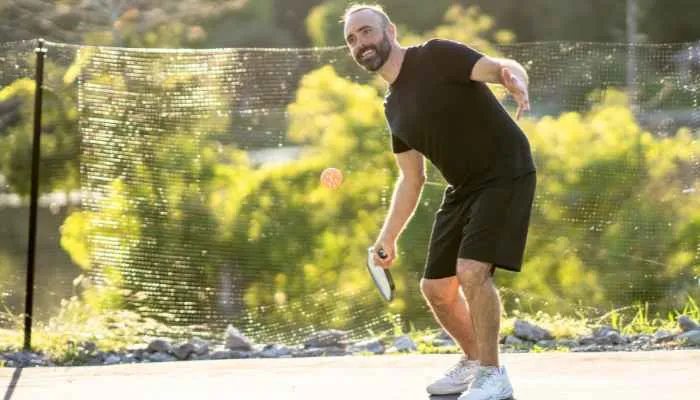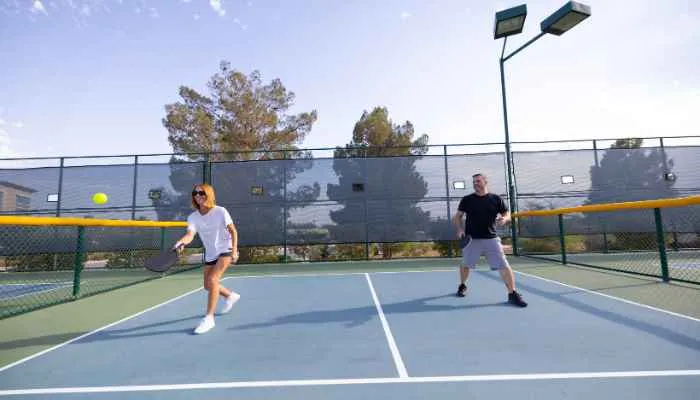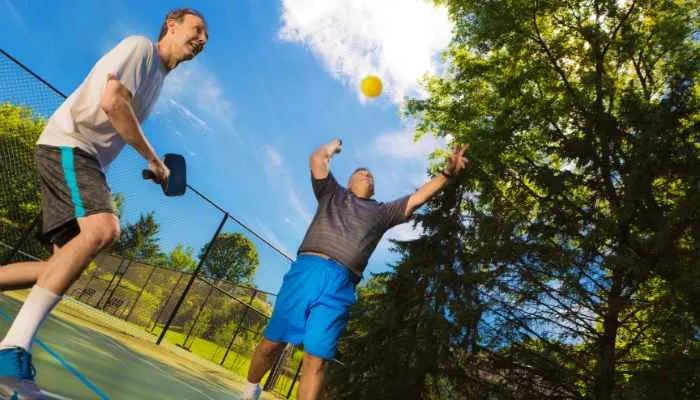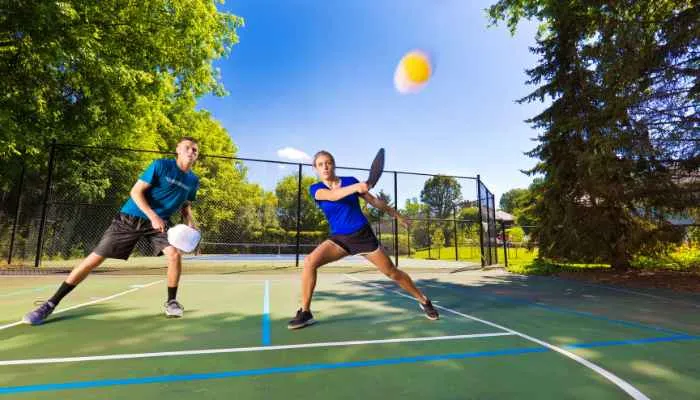Learn how to spike in pickleball like a pro! Discover tips and techniques for powerful and precise shots in this comprehensive guide.
Are you curious about the exhilarating move known as the spike and wondering if it’s allowed in this fast-paced sport? Well, wonder no more! In this blog post, we’ll dive into everything spiking in pickleball. From understanding a spike to exploring its rules, we’ll cover everything you need to know. So grab your paddle, and let’s smash our way through the world of pickleball spiking!
Table of Contents
Can You Spike in Pickleball
A spike in pickleball refers to a powerful shot executed from an overhead position to drive the ball downward into your opponent’s court. It can be an effective offensive strategy when used correctly.
But here comes the burning question: Is spiking allowed in pickleball? The answer is yes! Unlike other sports where spiking may be prohibited or restricted to certain court areas, pickleball will enable players to unleash their inner powerhouses with spikes.
Of course, like any other aspect of the game, there are rules surrounding spiking in pickleball. To execute a legal spike, you must stand outside the non-volley zone (known as “the kitchen”) during contact. Additionally, your shot should not violate any other rules, such as hitting out-of-bounds or causing interference with your opponents’ play.
Now that we’ve established that spiking is indeed allowed in pickleball, let’s delve deeper into what constitutes a legal spike and explore common mistakes to avoid when attempting this dynamic shot on the court. So stay here for more tips and techniques on how to become a smashing success at spiking in pickleball!

What Is a Spike in Pickleball?
A spike in pickleball is a powerful offensive shot that involves forcefully and aggressively hitting the ball downward toward your opponent’s side of the court. Players often execute it when the ball is above net level, enabling them to strike it with maximum force.
This shot requires precise timing, technique, and coordination. The objective of spiking in pickleball is to put your opponents on the defensive by hitting the ball with enough speed and accuracy that they need help to return it effectively.
Typically, players perform the spike near the net or the non-volley zone line. Players aim to hit the ball at an angle that makes it difficult for their opponents to react quickly and return it successfully.
When executed correctly, a spike can effectively score points or gain an advantage in a rally. However, mastering this shot takes practice and understanding proper form and strategy.
A spike in pickleball refers to a powerful offensive shot used strategically to pressure your opponents and create scoring opportunities. With practice and skill development, you can enhance your ability to execute successful spikes during gameplay.
- 5s survive against Drive in Dream Breaker
- Mastering the Pickleball Court: Footwork Drills to Elevate Your Game
- The Small-Town Kid Who Became a Pickleball Superstar! Dylan Frazier’s Inspiring Story
- Amazon Prime Day Pickleball Deals 2024: Take up to 50% Off on Paddles
- Pickleball’s ‘low-impact’ reputation doesn’t mean low-injury. How to stay safe playing the fast-growing sport.
Is spiking Allowed in pickleball?
The answer is yes! In pickleball, spiking is not only allowed but also an essential strategy for scoring points. A spike occurs when a player forcefully hits the ball downward into their opponent’s court, aiming to make it difficult for them to return.
However, like any other shot in pickleball, there are rules surrounding spiking that players must adhere to. One important rule is not to volley or hit a ball out of mid-air while inside the kitchen (the non-volley zone). You must have both feet outside this area before executing your spike.
To execute a legal spike, proper technique and positioning are crucial. When preparing for a spike, position yourself behind the baseline with enough space between you and the net. This allows you enough room to generate power and accuracy.
Regarding footwork techniques for spiking, it’s essential to approach the ball with small steps while keeping your weight balanced. This will help maintain control over your shot and prevent unnecessary errors.
Another aspect to consider is grip techniques to spike in pickleball. Use either an Eastern or Western grip on your paddle handle to maximize power and control during your spike. Experiment with different grips during practice sessions until you find one that feels comfortable yet effective for spiking.

Rules Surrounding Spiking in Pickleball
When it comes to spiking in pickleball, there are some rules that players must adhere to. The spike is a decisive offensive move that can give you an advantage on the court, but it’s essential to understand the guidelines set forth by the sport.
To ensure a legal spike, you must hit the ball carefully without touching any part of the net or crossing over into the non-volley zone (commonly known as “the kitchen”). Violating these rules will result in a fault against you.
Positioning plays a significant role in executing a legal spike. When attempting this aggressive shot, it must be correctly positioned behind the baseline. This allows you enough space and time to generate power while maintaining balance.
Improving your spiking ability requires practice and technique refinement. Focus on footwork techniques like stepping forward with your non-dominant foot for better weight transfer and power generation. Additionally, mastering various grip techniques can help improve control and accuracy during spikes.
Understanding these rules surrounding spiking in pickleball can elevate your game while ensuring fair play on the court. By practicing proper positioning and honing your skills through dedicated training sessions, you’ll become a formidable player capable of executing successful spikes within the boundaries of this exciting sport.
legal spike in pickleball
A legal spike in pickleball is when a player forcefully strikes the ball downward into the opponent’s court, intending to make it difficult for them to return. The key to a legal spike is that you must execute this within the boundaries of the rules.
In pickleball, specific guidelines surround spiking to ensure fair play and safety on the court. Players must be behind the non-volley zone (also known as “the kitchen”) when attempting a spike. This rule helps prevent excessive power and keeps players from getting too close to each other during gameplay.
According to official USAPA rules, players cannot hit a ball that has bounced off any part of their body or clothing before executing a spike. This ensures that only clean hits are considered legal.
Moreover, while spikes can be powerful shots, they should remain within the confines of good sportsmanship. Players must avoid intentionally aiming at opponents or using excessive force that may cause harm.
Understanding what constitutes a legal spike in pickleball is crucial for enjoying the game and respecting its rules and fellow players. Adhering to these guidelines can enhance your skills while playing fairly in this exciting sport!

Common Mistakes to Avoid When Spiking
Spiking in pickleball can be an exhilarating move that adds power and excitement to the game. However, like any skill, spiking requires practice and precision. Avoiding common blunders hindering your success on the court is crucial to maximizing your spiking opportunities.
One common mistake players make when attempting a spike is failing to time their jump correctly. Timing is crucial for a successful spike, as jumping too early or late can result in missed shots or net violations. Practice your timing by watching your opponent’s movements and anticipating when the ball will be within reach.
Another mistake beginners often need to pay more attention to using proper footwork during a spike. Your foot positioning is crucial in generating power and stability for an effective spike. Ensure you have a solid base by keeping your feet shoulder-width apart and transferring weight from back to front as you approach the ball.
A third mistake to avoid is relying solely on arm strength rather than using your entire body during a spike. While strong arms are beneficial, incorporating rotation from your hips and core will provide additional power behind each hit. Remember to engage these muscles while maintaining balance throughout the shot.
Many players overlook the importance of communication with their partner during doubles play. Clear communication ensures that both players understand who should attempt the spike and helps prevent collisions or missed opportunities due to confusion.
By being mindful of these common mistakes, you’ll be well on your way to mastering the art of spiking in pickleball! Practice regularly, focus on technique rather than brute force alone, and communicate effectively with teammates. These tips will help elevate your spiking ability and enhance overall gameplay enjoyment!
Positioning for a Legal Spike in Pickleball
Practice makes perfect! Take every opportunity during games or drills to work on your positioning skills for spiking. The more comfortable you become with finding the right spot on the court, the better your chance of executing a successful legal spike.
Remember that positioning is just one aspect of spiking in pickleball, but mastering it can significantly improve your chances of success. So get out there, practice diligently, and soon enough, those spikes will become second nature!
Strategies for Improving Your Spiking Ability
Spiking is an exciting and decisive move in pickleball that can help you gain an advantage over your opponents. If you want to enhance your spiking ability, here are some techniques to consider.
Footwork plays a crucial role in executing a successful spike. As the ball approaches, quickly position yourself near the net, ensuring your body is balanced and ready to explode into action. Use small steps or shuffles to adjust your positioning based on the ball’s trajectory.
The grip technique is essential for a controlled and powerful spike. Hold the paddle with a firm but relaxed grip, allowing for flexibility and wrist movement. You can maximize the force behind each spike by generating power from your core muscles and snapping your wrist at impact.
Furthermore, timing is critical when it comes to spiking in pickleball. Anticipate where the ball will be before it even arrives at your side of the court. This will give you that split-second advantage needed for an effective spike.
Practice makes perfect! Dedicate time to honing your spiking skills by participating in drills specifically designed for this technique. Work on accuracy, speed, and power with consistent repetitions.
By incorporating these techniques into your training routine and maintaining a focus on proper form and execution, you can improve your spiking ability in pickleball significantly! So get out there on the court and start refining those skills!
What to do in the kitchen in pickleball
The kitchen, also known as the non-volley zone, is an important area on the pickleball court. It’s a 7-foot zone that extends from the net on both sides of the court. You need to keep certain restrictions and strategies in mind when you’re inside this zone.
First and foremost, it’s crucial to understand that you cannot volley or spike while standing inside the kitchen. You can’t hit the ball out of mid-air before it bounces. Instead, you must play your short after a bounce.
So what can you do in the kitchen? One of your primary objectives is maintaining control over the game by spiking and dinking shots with finesse rather than power. Soft shots that drop just over or near the net are highly effective at keeping your opponents on their toes.
Another critical aspect of playing in the kitchen is footwork. You want to stay light on your feet and ready to move quickly if needed. Knowing where your opponent will hit their shot allows you to position yourself for optimal returns.
Also, good grip techniques can significantly improve your performance in this close-quarters play area. A continental grip is recommended for most shots near or within the kitchen, as it provides better control and accuracy.
Remember that spiking is not allowed when it comes to playing in pickleball’s kitchen area, but plenty of other skills and strategies are at play. Mastering soft shots, maintaining control through finesse rather than power, staying light on your feet with proper footwork techniques, and utilizing effective grip techniques will all contribute towards becoming a formidable player even within these restricted confines!
Can You Spike in the Kitchen in Pickleball?
Regarding pickleball, the kitchen is a key area of the court. It’s also known as the non-volley zone, and specific rules surround what you can and cannot do in this space. But can you spike in the kitchen? Let’s explore.
The Rules Surrounding Spiking in the Kitchen
According to official pickleball rules, players cannot volley or hit balls while standing inside the kitchen. This indicates that spiking is usually allowed outside of this specific area. This rule aims to prevent players from gaining an unfair advantage by smashing powerful shots close to their opponents’ feet.
What Constitutes a Legal Kitchen Spike?
Technically speaking, you should only execute spike shots outside the kitchen area. Once you step into that space, your options for aggressive shots become limited. However, it’s important to note that other ways exist to gain an advantage during gameplay without violating regulations.
Common Kitchen Court Strategies
One common strategy employed by skilled players is called “dinking.” This involves hitting softer shots with precision and placement instead of using brute force like spiking. By controlling their shots and aiming for strategic areas on their opponent’s side of the court, players can still create opportunities for winning points without risking penalties.
can you spike in the kitchen
Regarding spiking in pickleball, the kitchen – known as the non-volley zone – has its own rules. The kitchen is that 7-foot section on either side of the net where players are not allowed to volley or hit the ball out of mid-air. But can you spike in the kitchen?
The answer is yes! You can legally spike in the kitchen if certain conditions are met. First and foremost, your feet must be ultimately behind the line, marking the edge of the kitchen. This means you cannot enter or touch any part of this forbidden land before executing your spike.
Furthermore, it’s crucial to remember that while you can spike in this area, you cannot if you have both feet off the ground in contact with the ball. when coming into contact with a spiked shot, no leaping or jumping from inside or outside the kitchen.
To ensure a legal kitchen spike, keep one foot planted firmly on solid ground within this restricted zone while hitting downward on an opponent’s shot. This technique allows for control and precision without violating any pickleball rules.
Remember, mastering legal spiking techniques takes practice and finesse. So next time you find yourself near or inside that all-important non-volley zone, go ahead and unleash your inner spiker – follow those guidelines for a legal and successful play!
Common Kitchen Court Strategies in Pickleball
Players employ a few common strategies when playing pickleball in the kitchen, also known as the non-volley zone. These strategies can help you gain an advantage and score points while following the game’s rules.
One common strategy, “dinking,” involves hitting soft shots over the net to keep your opponents on their toes. Using this strategy, you can control the game’s pace and force your opponents into making mistakes.
Another effective strategy is to utilize quick volleys at close range. This allows you to pressure your opponents and prevent them from gaining rally control. You can keep your opponents off balance by staying close to the net and being ready for fast exchanges.
Additionally, many players use a technique called “third shot drops .”This involves hitting a gentle shot deep into your opponent’s court after they have returned a serve or third-shot drive. The objective is to force them back so they cannot approach the net quickly.
A different approach some players take is aggressive play at every opportunity. Instead of relying on finesse shots, these players look for opportunities to hit powerful spikes or smashes when their opponents provide weak returns or high balls within reach.
Spike Tips in Pickleball
Regarding spiking in pickleball, there are a few tips that can help you improve your game. First and foremost, timing is vital. Wait for the ball to reach its peak before making your move. This will give you the best chance of executing a successful spike.
Another critical aspect of spiking is positioning yourself correctly on the court. Ensure you’re in a position where you can generate enough power behind your spike while maintaining control.
Footwork plays a crucial role as well. Take small steps to ensure balance and stability as you approach the ball. This will allow for better accuracy and precision when spiking.
In terms of grip techniques, experiment with different grips to find what works best for you. Some players prefer an Eastern grip, while others may opt for a Continental grip. Find which suit you more comfortable and allows for maximum control.
Practice, practice, practice! The more time you spend honing your spiking skills, the better you’ll become. Incorporate drills into your training routine that focus specifically on the spiking technique.
Remember, mastering the art of spiking takes time and effort, but with these tips in mind, you’ll be well on your way to becoming an unstoppable force at the net!
Footwork techniques in pickleball for spiking
Footwork plays a crucial role when it comes to spiking in pickleball. It’s not just about the power and technique of your shot but also about how you position yourself on the court. Good footwork can help you reach an optimal position for a successful spike.
It’s also essential to have quick lateral movement skills. Changing sideways quickly will allow you to create space between yourself and defenders, giving you more room for an effective spike.
Additionally, practicing split-step footwork can significantly improve your spiking ability. When your opponent hits the ball, perform a small jump while landing with both feet simultaneously before moving towards the net. This split-second pause allows you time to assess the situation before proceeding.
Remember recovery footwork after executing a spike. Once you’ve made contact with the ball, quickly reset back into position so you’re prepared for whatever comes next – whether defending against a counterattack or transitioning into another offensive play.
Mastering these various footwork techniques will undoubtedly enhance your spiking abilities in pickleball by ensuring proper positioning and agility on the court!
Conclusion
While spiking in pickleball may not be as common or pronounced as in volleyball, the principles of forceful, downward shots can still be effectively applied to elevate your gameplay. By mastering spike in pickleball techniques, timing, and strategies discussed in this article, you can surprise opponents, gain an advantage, and inject an element of excitement into your pickleball matches.
Remember that adaptation and creativity are essential in this sport, allowing you to harness the power of spiking while respecting the nuances of pickleball’s unique dynamics.
Can I use a two-handed grip for spiking?
While a two-handed grip can be useful for beginners, most advanced players prefer a one-handed backhand grip for better control and precision.
Is spiking in pickleball legal?
Yes, spiking is allowed in pickleball as long as you follow the rules regarding positioning and shot execution.
Are there any specific drills to improve my spiking skills?
Absolutely! Consider practicing with a partner who can feed you shots to spike. You can also work on your footwork and timing by simulating game situations.

